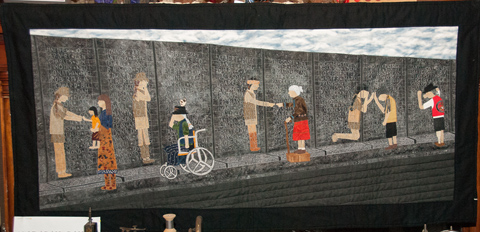
Award winning, Navajo, quilt maker, Susan Hudson | Image source: Native Peoples Magazine
Susan Hudson (Navajo) sews together fabrics and history in her award-winning ledger-like quilts. Hudson, the 2015 Eiteljorg Museum Indian Market and Festival Best of Show winner, continues to take top prizes for her beautiful and haunting work.
Award-winning Navajo quilter Susan Hudson’s inspiration comes from her ancestors—specifically, from her grandmothers, who, like many Native American people, were forced to attend federally run Indian boarding schools.
“When I do these quilts it’s to honor my ancestors, [my] grandmothers,” says Hudson, 57. Her work “speaks for the ones that can’t speak for themselves. It honors all who were sent to boarding schools and forced to sew.”
Hudson’s prize-winning quilt, Nii’ Da’ Ba’ Hii Ba’ Hane’ (“Warrior Story”), was named 2015 Best in Show at the Eiteljorg Indian Market and Festival in Indianapolis. Her entry beat out more than 200 others last summer, and the same quilt captured a first-place prize at the 2015 Heard Museum Guild Indian Fair & Market in Phoenix.
Reminiscent of the Vietnam Veterans Memorial wall in Washington, D.C., the quilt shows a dark wall of names in white letters, with Native people standing next to it mourning the names and shadows of the fallen. It represents Native American history, Hudson says.

“I wanted to tell something about our warriors,” Hudson says. “If you really look at it, it’s pages of paper showing names in English of men and women. When invaders came, they didn’t want to learn our beautiful names.”
Jaq Nigg, festivals and markets manager with the Eiteljorg Museum, says the judges were impressed by Hudson’s inspired combination of quilting and ledger art.
“The care that she puts into her work is extraordinary,” Nigg says. “The stories she tells in her work, especially that piece …. It was amazing, an exquisite piece.”
Hudson says she plans to show again at this year’s market and festival in Indianapolis, where she’s competed since 2011.
“I like Eiteljorg,” she says. “It’s a whole different vibe—clientele—compared to [Indian art markets in] the Southwest. They really have a nice, wonderful program.”
Hudson’s newest work, “The Walk of My Ancestors,” depicts the utter violence that befell the Navajo people as they were forced on the Long Walk in the mid-1800s. That piece won a blue ribbon in its division at the 2016 Heard market in March.
Hudson’s show quilts take her about 18 months to finish. She learned to sew as a child and sews in her free time in her Sheep Springs, New Mexico, home.
Hudson hasn’t decided what to do with her prized quilt and is keeping it for now. Her quilts are popular and have already gained the attention of collectors worldwide. The National Museum of the American Indian in Washington, D.C., purchased one of her quilts, and she’s been invited to show her quilts as far away as Switzerland and Australia.
“I want to break through in a non-Native (sewing) world and tell our stories,” she says. “I think I’m doing that.”
This summer’s Eiteljorg Indian Market and Festival is scheduled for June 25 and 26 and will take place on the museum grounds, a change from past years. For the last 15 years, Nigg says the market was held at a nearby public park, which hurt museum attendance and was routinely affected by rain and muggy weather. Nigg hopes that this year’s event, which is partially indoors and can accommodate 7,000 visitors, improves both market and museum attendance.
Katrina Mitten (Miami) is this year’s Eiteljorg Indian Market signature artist for her award-winning beadwork. Hoop dancer Nakotah LaRance (Hopi/Tewa/Assiniboine), who took first place for the second time at the Heard Museum’s World Championship Hoop Dance Contest earlier this year, is scheduled to perform.
This year, Hudson’s featured quilt is named “The Walk of My Ancestors.” It depicts the infamous Long Walk of the Navajo, during which her ancestors and hundreds of Diné were removed from their Arizona homelands in 1864 by the U.S. government and forced to walk more than 300 miles to eastern New Mexico. Some 200 Navajos died as a result of the forced removal. The quilt shows the dark history of the U.S. government’s relationship with Native people.
But it also shows the Navajo people surviving. “My grandmas were on the Long Walk,” Hudson explains. “If it wasn’t for them, I wouldn’t be here. This is my way of honoring them, honoring us.”
Seven years of Best of Show winners at the Eiteljorg Indian Market and Festival:
2015: Susan Hudson (Diné), weavings and textiles, Nii’ Da’ Ba’ Hii Ba’ Hane’ (“Warrior Story”)
2014: Ronnie-Leigh Goeman (Onondaga) and Stonehorse Goeman (Seneca), basketry with sculpture, “Blue Herons Basket”
2013: Summer Peters (Ojibwe), beadwork, “Gentleman Jim”
2012: Cherrish Parrish (Gun Lake Band Potawatomi), basketry, “The Next Generation II”
2011: Charlene Holy Bear (Standing Rock Sioux), dolls, “A Lakota Butterfly”
2010: Dominique Toya (Jemez Pueblo) and Jody Naranjo (Santa Clara Pueblo), pottery collaboration
2009: David R. Boxley (Tsimshian), carvings, paddles
About Eiteljorg:
The Eiteljorg Museum of American Indians and Western Art is located in Indianapolis’ White River State Park, at 500 W. Washington, Indianapolis, IN 46204. For general information about the museum, exhibits and events, call 317/636-WEST (9378) or visit www.eiteljorg.org.
This article was written by Dalton Walker (Red Lake Ojibwe) and republished with permission from Native Peoples Magazine from their May – June 2016 edition. Dalton Walker is a journalist living in Arizona. He serves on the Native American Journalists Association board of directors. You can follow him on Twitter @daltonwalker.









